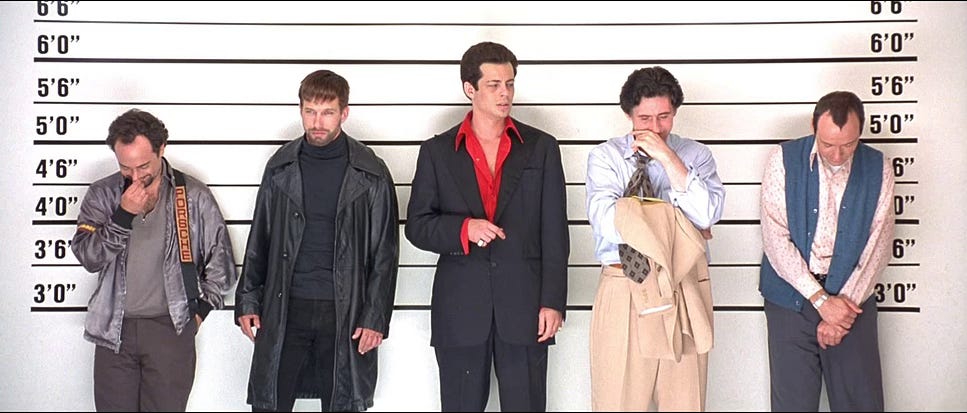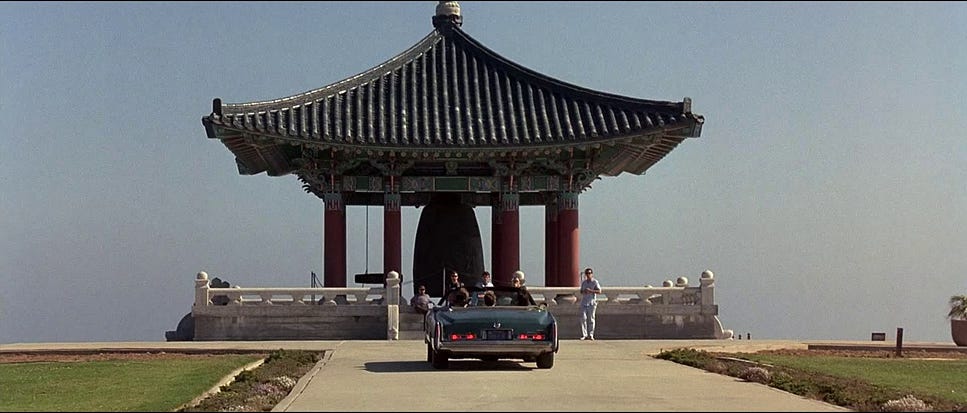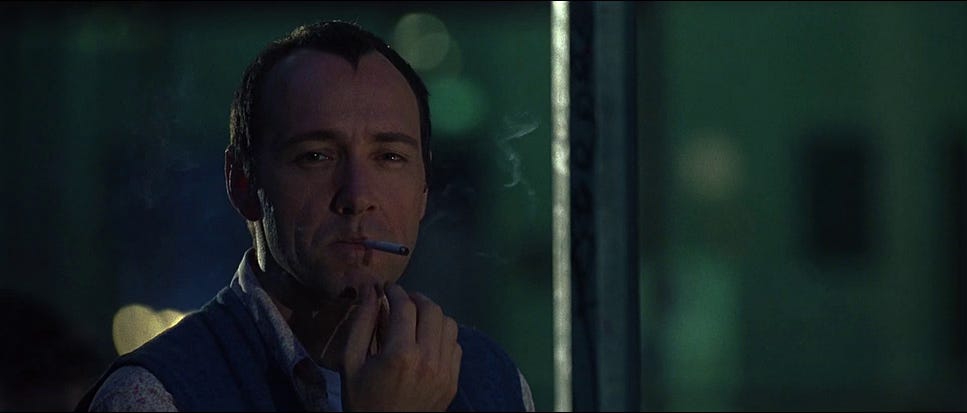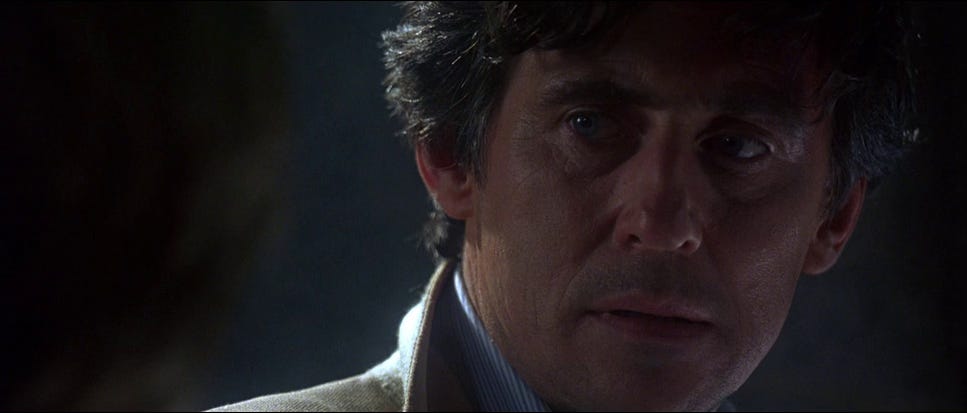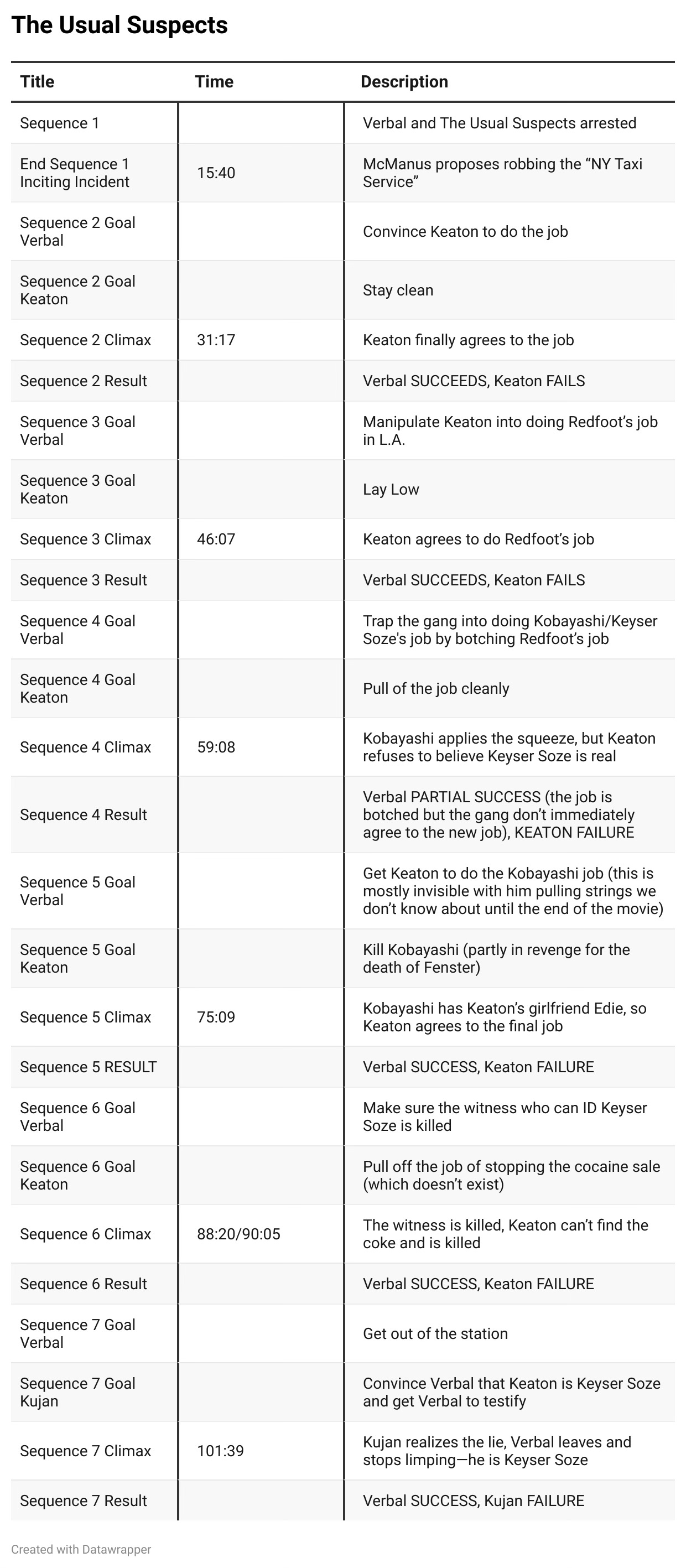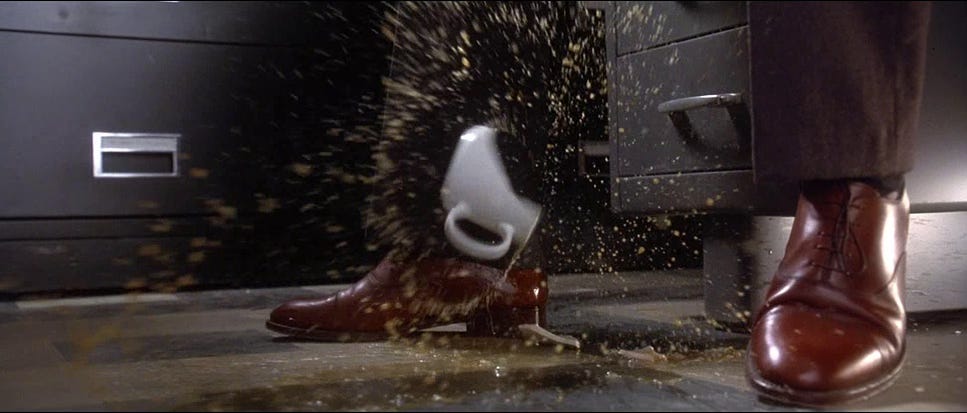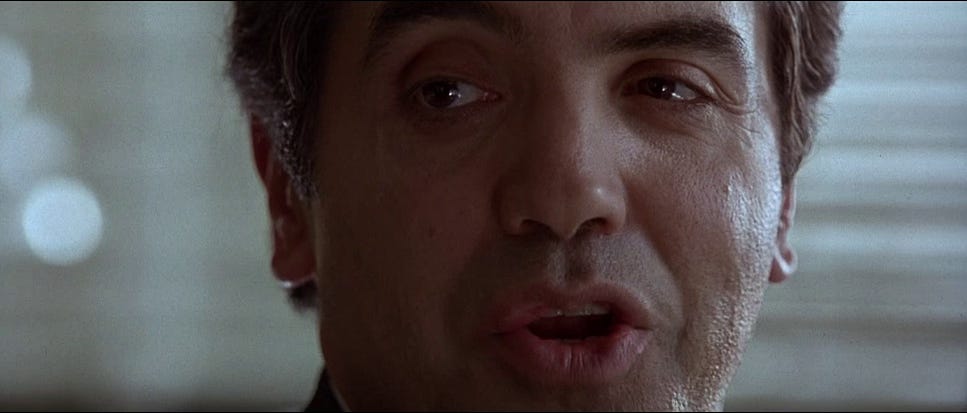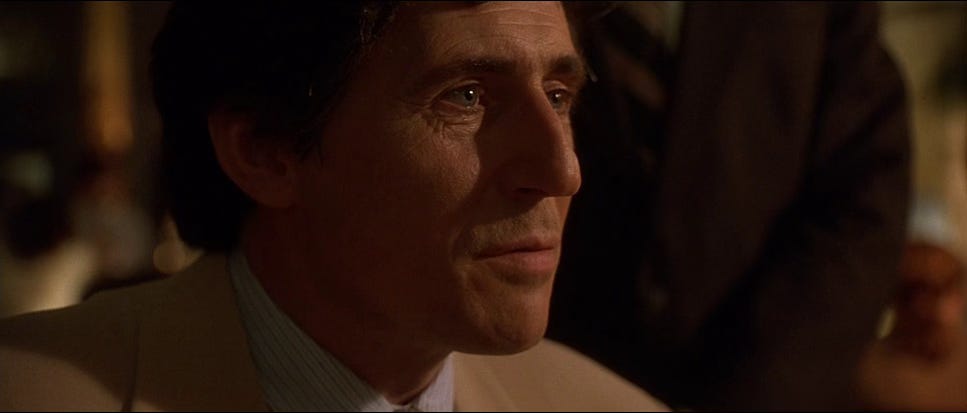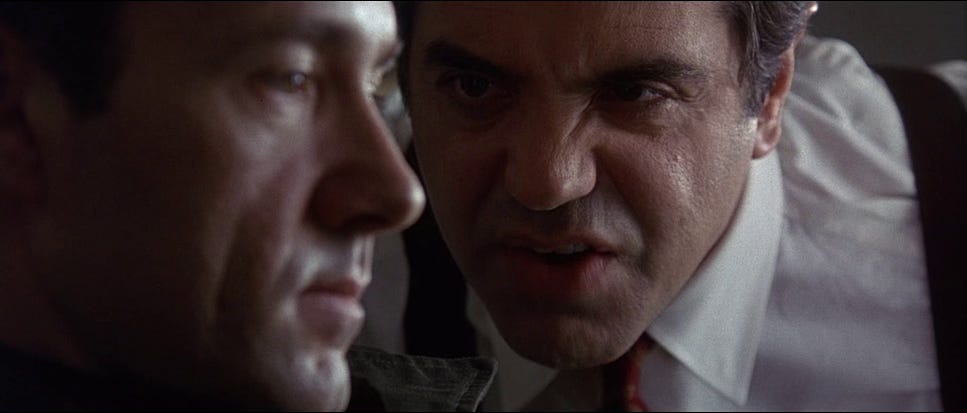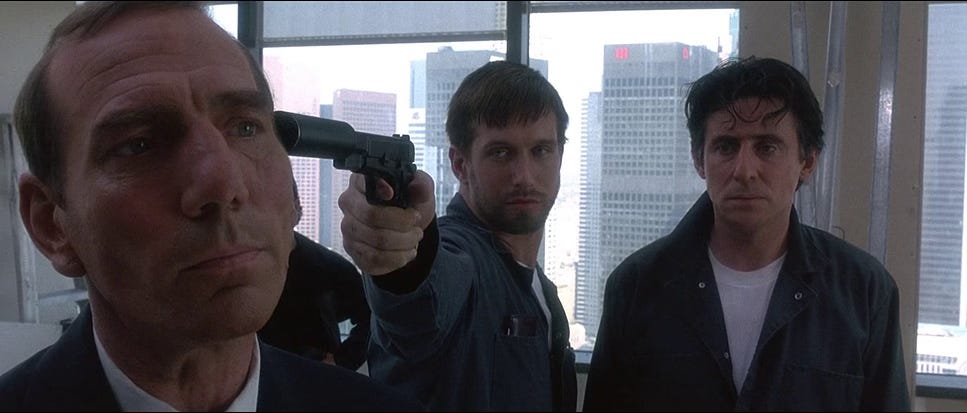The Usual Suspects
The Usual Suspects was one of the most celebrated crime thrillers of the 1990’s, growing out of the gritty, quirky trend started by Quentin Tarantino with Reservoir Dogs and later Pulp Fiction. Directed by Bryan Singer (who went on to direct a number of X-Men movies) and written by Christopher McQuarrie (who wrote and directed the final four Mission Impossible movies, as well as writing a number of other Tom Cruise vehicles), The Usual Suspects has long been known for its famous twist ending. With that in mind you should 100% watch this movie before reading on.
Twist ending aside, The Usual Suspects has a number of unique narrative features from a false protagonist, a protagonist who is actually an antagonist, two parallel antagonists, and an unusual seven sequence structure. All of this made The Usual Suspects the perfect choice to discuss with Donavon and Daniel on The Reel Therapy podcast, which you can watch below (or find on any popular podcasting platform).
As always, these breakdowns contain SPOILERS, and are only recommended if you've already seen the movie. You can check my introduction to these breakdowns, to get an overview of my process and philosophy.
Feel free to let me know what you think in the comments below!
The Basics
Director: Bryan Singer
Writers: Christopher McQuarrie
Release Date: 1995
Runtime: 106 minutes
IMDB: https://www.imdb.com/title/tt0114814/?ref_=fn_all_ttl_1
Movie Level Goals
Protagonist: Verbal Kint (Keyser Soze)
External: Kill the witness and escape police custody with his secret identity intact
SUCCESS | FAILURE | MIXED
Internal Goal: None
Protagonist of Verbal’s Story: Keaton
External: Pull of the job of stopping the cocaine sale
SUCCESS | FAILURE | MIXED
Internal Goal: None (though he has goals of going straight and having a relationship with Edie, neither of these plays out as fully developed goals)
Three Observations
Observation #1: Two Protagonists—The Story within a Story
I generally define the protagonist of a film as the character whose goal structures the movie and/or the character who has the strongest internal goal. As a crime thriller, The Usual Suspects focuses exclusively on external goals, and is where we’ll look to find our protagonist. What makes The Usual Suspects interesting is the unfolding of the movie and the shifting sands of establishing the protagonist.
Once the foreword ends, we focus on the present timeline which involves the cop Dave Kujan (Chazz Palmenteri) and the criminal he is questioning, Verbal Kint (Kevin Spacey). Already, the movie makes it a little difficult to figure out whose story we are following. Often in crime thrillers, it’s a cop or detective who serves as the protagonist, and his or her goal that structures the movie (usually solving the crime). And in The Usual Suspects it might make perfect sense that Dave Kujan would be our protagonist.
But as he talks with Verbal, we quickly begin to see that Verbal will be telling us the story of the crime at the center of the story—the blowing up of the ship and the killing of dozens of people. In the scenes with Kujan and Verbal, Verbal clearly has the majority of lines and screentime, and of course he also features in the story he is telling. So this might indicate Verbal is our protagonist. However, Kujan’s goal is clear and structural: to solve the crime. Verbal’s goal, at the start, is less clear, other than to tell the story.
The other important factor is that in movies where we have an in-movie storyteller, often narrating past events in voice over, the storyteller is often NOT the protagonist. This is true of a classic like Citizen Kane, where The Reporter is the storyteller, but is obviously not the protagonist. This is also more complicated, but equally true with The Virgin Suicides, where one of the boys obsessed with the Lisbon girls narrates, but is never clearly identified, and is not the protagonist of the story. So our expectation is often that if a movie has a narrator or storyteller featured as a character in the movie they are often not the protagonist (this is different than when the protagonist also has voice-overs explaining their thoughts or feelings).
The idea that Verbal as the storyteller is not the protagonist is reinforced by his telling of the story. Within the story of the coming together of the “Usual Suspects” and the series of crimes they commit, Keaton (Gabriel Byrne) is positioned by Verbal as the protagonist of the story within a story. Keaton is a disgraced cop who is trying to go straight. He has a girlfriend who is a lawyer. He’s invited to participate in a crime, but initially refuses. These are attributes we might see in a classic protagonist. He has a romance, and at least the possibility of an internal goal. And, overall, I think it’s safe to say that Keaton IS the protagonist of Verbal’s story, as he tells it.
The problem is twofold, and is revealed at the end of the movie. First, we discover that Verbal is Keyser Soze, and though much of his story may be true he has also shaped the story to manipulate Kujan into believing that Keaton is Soze. That means it becomes hard to trust everything that Verbal has said about Keaton (that he was trying to go straight, for example). Second, and more importantly, once Verbal is revealed as Keyser, a number of realizations snap into place. We now understand that Verbal/Keyser and not Kujan is the protagonist of the present timeline story. He does have a goal that structures the movie—to convince Kujan that Keaton is Keyser and to escape the police station with his secret intact. Additionally, we also come to understand that Verbal/Keyser was also the protagonist of the story within the story. For every sequence level goal listed above for Keaton, we see a matching goal listed for Verbal/Keyser and realize that it he was pulling the strings all along, and it was his goal dictating the actions of the “Usual Suspects.” It’s obviously incredibly difficult to pull off this sort of “shell game” of protagonists and Christopher McQuarrie does it brilliantly in The Usual Suspects.
Observation #2: Two Antagonists, Two Timelines
Having established Verbal as the protagonist, and recognized that we have two storylines (the heist flashback and current timeline interrogation), we begin to understand that The Usual Suspects has also cleverly created two antagonists, one in each storyline. Of course all of this is dependent on our understanding of Verbal being the protagonist, rather than an antagonist. In essence, we simply having a flipping of roles. In the present day story, Kujan, even though he is a cop on the side of the law, becomes Verbal’s antagonist, as he is the main character who stands in the way of Verbal/Keyeser completing his goal. Additionally, we understand that Verbal is manipulating Kujan the whole time. After all, we learn early on that Verbal has full immunity—he has no reason to talk to Kujan at all. But he does so in order to convince Kujan that Keaton is Keyser. And cleverly he does this through reverse psychology. He praises Keaton, sees Keaton as a leader, insists that Keaton is NOT Keyser, which all feeds Kujan’s belief that Keaton actually is Keyser. We should also note that despite masterminding all of this, Verbal/Keyser does in some ways fail at his final goal (though the film doesn’t really emphasize this). As Verbal leaves, drops his limp, and is revealed to be Keyser, Kujan realizes the story is a lie and gets the witness’s artist sketch showing that Keyser looks a lot like Verbal. Verbal does escape, but his attempt to cast Keaton as Keyser has actually failed, and while Verbal/Keyser may be in the wind, never to be found, Kujan actually has a lead to try to track him down (a lead that Verbal/Keyser may not know about).
Within the flashback storyline, Keaton flips from protagonist to antagonist, as Verbal constantly works to manipulate Keaton into the positions he wants him in, culminating in Keaton agreeing to attack the ship and try to stop the cocaine sale. There are a couple of interesting notes here as well. First. Kobayashi tells the “Usual Suspects” that each one of them has wronged Keyser Soze in some way. We never have confirmation that this is true, but if it is, then we have an additional reason for Verbal/Keyser to want to bring harm to Keaton. Second, it’s also worth noting that while Verbal/Keyser seems like a mastermind who is always multiple steps ahead, Keaton does surprise him at least once. At the end of Sequence 4, Kobayashi seems to have the goods on the gang, and presumably they have no choice but to agree to the plan to disrupt the drug transaction. But Keaton is made of slightly firmer stuff. He refuses to belief Keyser is real, and after Fenster is killed, he reacts by deciding to go after Kobayashi and kill him. This plan might have worked, but of course Verbal is an inside man, and when Keaton grabs Kobayashi and threatens to kill him, Kobayashi has the insurance of having arranged for Keaton’s girlfriend Edie to be in Los Angeles working with Kobayashi. At that point, Keaton agrees to disrupt the cocaine deal, only to discover that there is no cocaine (and only for us to discover that the entire plan was to kill the one witness who could identify Keyser Soze).
Observation #3: Seven Sequences
One of the oddities of The Usual Suspects is its seven-sequence structure. Often, sequences correspond roughly to acts, so if you’ve got three acts, and two sequences per act, you’d have six sequences. Of course, this isn’t always the case, and some movies do have strange numbers of sequences (Casino Royale, for example has 11 sequences). In the end, movies with sequences and no acts, have a variety of reasons for the number of total sequences. However, in the case of The Usual Suspects, I think there is a somewhat clear cut reason for seven sequences. For the most, the sequences do somewhat correspond to typical act structure. The climax of Sequence 1 at the 15:40 mark does also serve as the inciting incident. With that in mind, the Sequence 2 climax at 31:17 roughly corresponds to our normal expectations for an Act 1 Climax. Following that line of thinking, Sequences 3 and 4 would correspond to a typical Act 2. And indeed, the climax of Scene 4 has Kobayashi putting the squeeze on the “Usual Suspects” marking their lowest point of the movie and their first true encounter with a representative of their antagonist, which often corresponds to an Act 2 climax in a three-act structure. Sequences 5 and 6 then roughly correspond to an Act 3, climaxing with the death of Keaton. But, of course, the key to The Usual Suspects is that Keaton’s death isn’t the end of the movie. We need one more sequence, so in Sequence 7 we have Kujan seemingly turning the screws on Verbal to convince him Keaton is Keyser Soze, only for the big reveal that Verbal himself is Keyser. Sequence 7 is the shortest in the movie at around 10 minutes, which makes total sense given that there is very little plot left to unfold, other than the final reveal.
Overall, The Usual Suspects is fascinating from a narrative and structural point of view and reveals the ways in which clever filmmakers can take the basic assumptions of protagonist, antagonist, and structure, and play with them in unconventional ways to surprise audiences.

